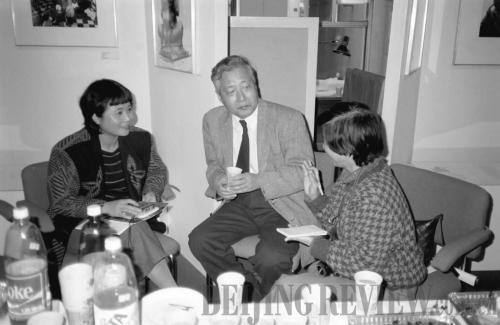 |
|
BIG STAR: Yu Shizhi (center), a leading actor of the Beijing People's Art Theatre who starred in the classic drama Teahouse, speaks to journalists in Hong Kong in April 1986 (XINHUA) |
When speaking of BPAT, the first thing that comes to mind is Yu Shizhi, star of Long Xu Gou. In the drama, he played the part of a poor artist who was driven crazy by the absurd society that preceded the People's Republic of China.
His successful stage career included a starring role as the Chinese leader Mao Zedong (1893-1976) in opera Long March.
As a practitioner and teacher of the Theory of Inner Vision, he was an outstanding representative of BPAT's performance style.
Born in Tangshan, north China's Hebei Province, on July 9, 1927, Yu was regarded as a highly accomplished actor. Though he left the stage many years ago, his legacy continues. His expressions on stage have become part of the curriculum at drama schools, and his performances have been adopted and modified by many other actors.
"Experienced actors can form a unique personal charm through their inner refinement, as well as their interpretation, understanding and imagination of performance arts. You can see this kind of quality in the older generations of actors at BPAT," said Yang Qianwu, Vice Chairman and Secretary General of Beijing Dramatists Association.
"The audience isn't just appreciating a character; they're also appreciating the actor's personal charisma. An actor without stage presence is dull," said Yang.
Yu's peak performance was in Teahouse, a drama written by Laoshe known for boasting the highest achievement of BPAT.
Published in 1957 and brought to stage in 1958, Teahouse is not only Laoshe's best dramatic piece but also a monumental work in the history of modern Chinese drama.
But few people know that Yu also made significant contributions to the creation of the script. For instance, he suggested Laoshe change the ending as a discussion between three old men and make his characters commit suicide in despair. Yu's suggestions strengthened the drama's sense of tragedy and formed a memorable climax at the ending.
The play depicts 70 characters over a period of 50 years spanning three dynastic periods. It is an epic play with a high degree of artistic integrity, conspicuous national characteristics and historical accuracy.
Though the play has few major events, nor much suspense or conflict, it managed to grasp the audiences' attention via the characters, dialogues and acting.
Performed abroad since the 1980s, the drama has been well received in the United States and European countries.
| 